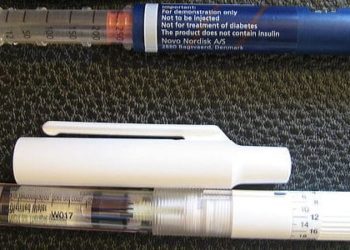Steroid implant may improve diabetic macular edema
1. Both the 0.35mg and 0.7mg dexamethasone dosing led to a significant increase in visual acuity compared to sham.
2. Central retinal thickness, a measure of the extent macular edema, was decreased significantly in the 0.35mg and 0.7mg dexamethasone treatment groups.
Evidence Rating Level: 1 (Excellent)
Study Rundown: Diabetic macular edema (DME), a common complication of diabetic retinopathy, causes an accumulation of fluid beneath the macula partly due to inflammation. While laser treatment and anti-angiogenic treatments have been utilized, steroid treatments have also been explored. In this study, the authors demonstrated that a sustained-release implant of dexamethasone within the eye can lead to improvement in visual acuity of DME patients lasting up to 3 years. However, the treated patients were more likely to develop cataracts. Limitations of the study include that the trial did not include a treatment arm of the current standard of care. In addition, over 2/3 of the patients had been previously treated; it is unclear how prior treatments may have affected their response to steroids. The increased risk of cataract also must be considered. Nonetheless, the study ultimately demonstrates that steroid therapy may be a valuable option for DME, although their efficacy ought to be compared to current DME therapeutics.
Click to read the study in Ophthalmology
Relevant Reading: Association of Vitreous Inflammatory Factors with Diabetic Macular Edema
In-Depth [randomized controlled trial]: Patients with diagnosed DME (per decreased visual acuity and increased central retinal thickness) were randomly selected to either receive a sham procedure, implant of dexamethasone 0.35mg, or an implant of dexamethasone 0.7mg in this multi-center trial. Patients were regularly followed for 3 years, during which their visual acuity and central retinal thickness was assessed with repeat injections as needed. The primary endpoint was percentage of patients with an improvement of 15 letters in visual acuity. Both the 0.35mg and 0.7mg dexamethasone dosing led to a significant increase in visual acuity compared to sham (18.4%, 22.2%, and 12.0% respectively; p<0.018). Central retinal thickness decreased significantly by 107.9µm and 111.6µm in the 0.35mg and 0.7mg dexamethasone groups compared to the control group (41.9µm; p<0.001). Patients in the treatment arms developed cataract more rapidly, which limited visual acuity but were treated during the study. Overall, steroid treatment of DME appears to be a viable therapy.
More from this author: Argus II retinal prosthesis significantly improves spatial vision in blind patients, Artificial cornea is well retained in patients with ocular surface disease, High prevalence of undiagnosed glaucoma in West Africa, Interferon therapy is superior to methotrexate for uveitis, Rho kinase inhibitor safely reduces intraocular pressure
Image: PD
©2012-2014 2minutemedicine.com. All rights reserved. No works may be reproduced without expressed written consent from 2minutemedicine.com. Disclaimer: We present factual information directly from peer reviewed medical journals. No post should be construed as medical advice and is not intended as such by the authors, editors, staff or by 2minutemedicine.com. PLEASE SEE A HEALTHCARE PROVIDER IN YOUR AREA IF YOU SEEK MEDICAL ADVICE OF ANY SORT.


![2 Minute Medicine: Pharma Roundup: Price Hikes, Breakthrough Approvals, Legal Showdowns, Biotech Expansion, and Europe’s Pricing Debate [May 12nd, 2025]](https://www.2minutemedicine.com/wp-content/uploads/2025/05/ChatGPT-Image-May-12-2025-at-10_22_23-AM-350x250.png)






